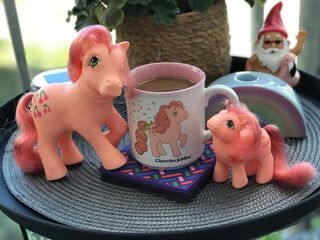Play
The Rediscovery of Cherries Jubilee
A queer metaphor for material culture and psychological safety.
Posted October 11, 2021 Reviewed by Gary Drevitch
Guest post by psychotherapist Peter Andrew Danzig (they/them), national speaker on Geek and Pop Culture and author of the upcoming book Don't Toy with Me: A Geek's Road to Acceptance, Calm, and Expression.

The clock strikes 2:45 PM. It’s 1992. I recall the frantic rush of second grade, gathering my coat and Little Mermaid lunchbox and dashing for the door. The objective: Get the first window seat on the bus near the bus driver. It's a daily effort to evade the cruel bullying of a child still oblivious as to their “queerness” but aware of their difference from the other boys. The queer child is me. My armor: Cherries Jubilee, a vintage My Little Pony. It was my comfort item when being pushed, shoved, or name-called. En route, I stop at the water fountain for a quick drink of water. Minutes later. I’m safely tucked away at my window seat, the fall air coming in through the window. I'm safely within the eyesight of the driver, and I know my Dad will be there to catch my small jump off the bus. I look down and notice something missing. She’s gone, left astray at the water fountain, holding my sense of security in her lovely peach locks. At home that evening, I feel the sense of loss, but home is a safe place where, although assigned male at birth, my family didn’t gender our experience. I’m in my room, surrounded by my unicorns, mermaids, dolls, and specifically, Hasbro’s genius creation of My Little Ponies. My father and mother tried their best to find a replacement, but the toy line, ironically, had ended that year and she was specifically produced eight years prior. There was no chance of getting her back.
Or so I thought.
Today, due to the magic of eBay, and the current trend for nostalgia toys produced by the pandemic, with the collectibles market finding footing after a 20-year decline, I am comforted because Cheeries Jubilee — both the vintage edition and a new one created by a company called Basic Fun — sits on my bookshelf. As a Gender Queer trauma therapist, I find it interesting that looking at this small plastic horse, I can find the trace roots of the need for safety in material culture. It’s not lost to me that she supports me, this small toy, as I help clients navigate trauma, pain, and hardship. We often pathologize people’s relationship to collectibles, especially toys, and I find that there seems to be an unconscious bias in the realm of psychological research being dismantled by us Geek Therapists. I love the title, but I also reframe it to clients as simply authentic and relational — meaning, I don’t hide from my clients. If I did, that small child looking for safety on a bus, toy in hand, never found themselves. But I have, and continue to discover more in my relationship to toy collecting, geek culture, and psychotherapy.

Researcher Lambros Malafouris states: “Consensus is growing, in many areas of the humanities and social sciences, that aspects of the material world we live in have causal efficacy on our minds – the major dynamic being the plasticity of the brain linked to the affordances of our bodily engagements with things. The implications of that on how we approach and understand important mental health issues have not been adequately addressed.”
I couldn’t agree more, I recall every stage of life, accompanied by those vintage toys purchased in my childhood, from formed friendships at conventions, to sitting at my desk in my graduate residency placement, to today as a signature part of my research focuses on the impacts of toy collecting and geek culture in the fields mental health and social sciences. There was a time when my work, and the work of my colleagues — specifically the founder of Geek Therapeutics, Anthony Bean — was considered niche, and possibly not clinically relevant when predominant styles of approach were CBT, DBT, and EMDR. Where does authenticity, use of self, and material culture fit in if we are only focused on behavior change?
I often work with trauma survivors, and one of the questions I leave room for is always: What hobbies, if any allow you to feel safe? Or, more likely, the “eclectic” — again, I'd say authentic and transparent — décor of my office leads to them discussing an item, collection, or sense of identity outside of their traumatic experience that allows them to feel excited, safe, or part of a community, be it toy collecting, gaming and comic culture, or pop culture. They feel human, seen, and heard. That’s not to say that I don’t mix my clinical approaches, because it most certainly serves my practice to engage each person individually in their therapy.
What I’m saying is, don’t discount the sense of grounding, healing, or reflection that material items can bring, and let’s leave behind the biased notion that adulthood means we leave our sense of play behind. Play is integral to the human experience, and our plasticity is connected to engaging with play. The definition of play, in my opinion, should be self-defined. However, I encourage all of us — clinicians, clients, patients, doctors, all simply people — to look around, rummage that old attic box of childhood memories, and see what it brings up.
She’s looking at me now with blushed cheeks and green eyes, atop a box reminding me to find “beauty in the little things." For me, this little thing, this chubby, plastic horse, is the beauty. This toy transported me to magical worlds as a queer child, helped me navigate my queer identity, and to this day, serves as a reminder that in my time with others, it’s the little things that lead to big discoveries.
For National Coming Out Month, I invite you, or those your support in your practice, to “come out” of hiding if your sense of play lives in something geeky, quirky, or nostalgic, because for me, part of my coming out and my experiences was formed by knowing there was a safe haven in my material world. Who knows, maybe now I’ll take up horseback riding as a hobby; maybe that’s how Cherries Jubilee can be celebrated, by leading to yet still, new experiences.
My inner child attained their goal. They found safety through play, and found their people and their queer identity. I look back to that child and say now, “Don’t worry, she may be lost, but she’s not forgotten. And one day, she’ll inspire you to write your story, and guess what, there are conventions, toy shows, and people who will consider your interests valuable, and you will feel seen, heard, and loved. Your loss will lead you on quite a journey to find her again and when you do, you’ll find yourself.”


